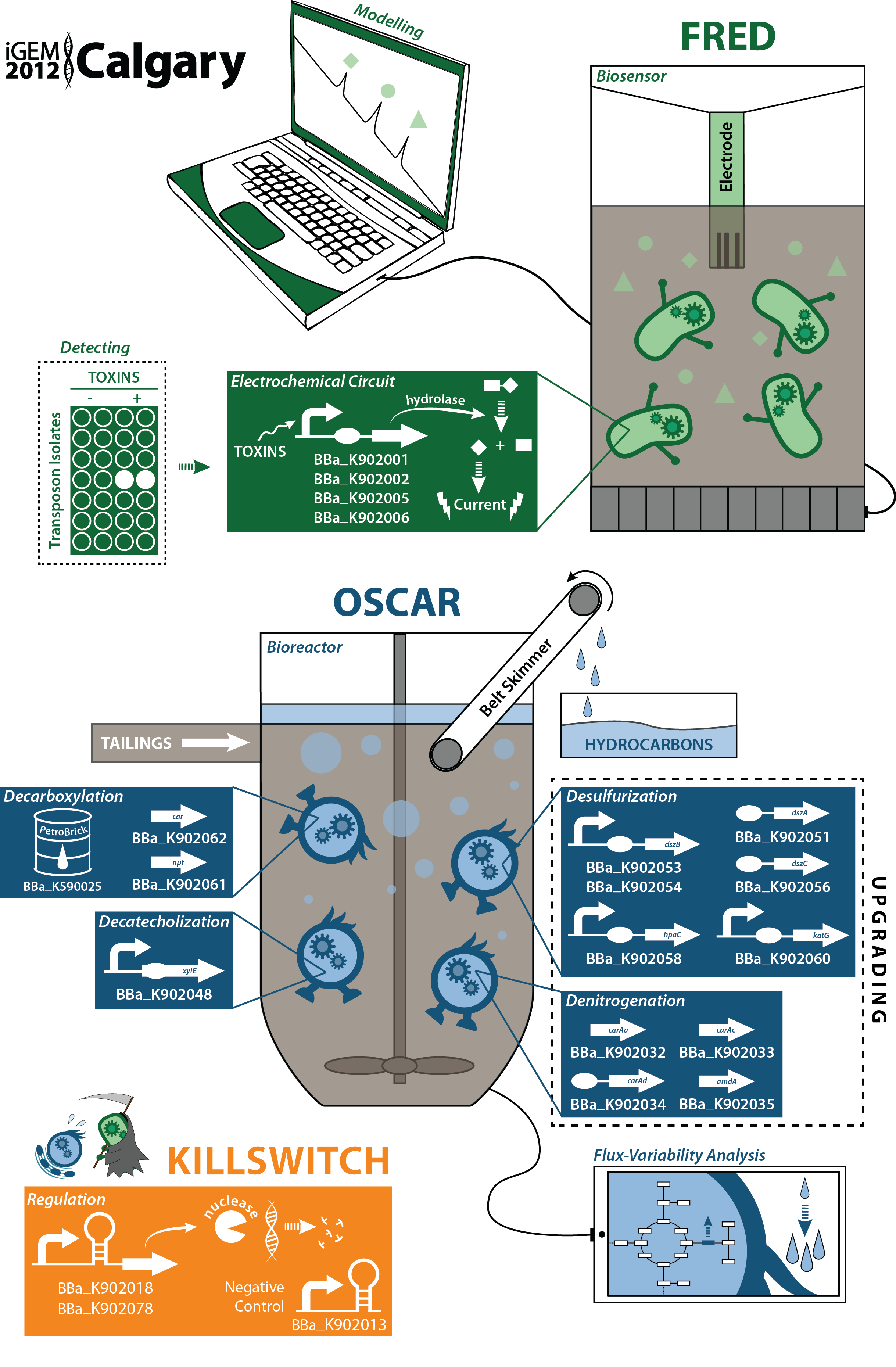Team:Calgary/Project/DataPage
From 2012.igem.org
Emily Hicks (Talk | contribs) |
|||
| Line 7: | Line 7: | ||
<h3>Detect and Destroy</h3> | <h3>Detect and Destroy</h3> | ||
| - | <p>The Calgary team has developed a duel system for the detection of toxic components in tailing ponds as well as the remediation of these compounds. Tailing ponds are large | + | <p>The Calgary team has developed a duel system for the detection of toxic components in tailing ponds as well as the remediation of these compounds. Tailing ponds are large bodies of water containing waste products produced from the extraction of bitumen in the oils ands. Our biosensor involved the identification of a toxin promoter through a transposon screen. An electrochemical detector was implemented with a multiple output system allowing for the detection of multiple compounds simultaneously. This promoter/detector system was then complimented with the production of a biosensor prototype involving both a physical device and a software program for easy data analysis.</p> |
| - | <p>Rather than just sensing toxins in the tailings ponds, our major objective were to detoxify the tailings through the reduction of | + | <p>Rather than just sensing toxins in the tailings ponds, our major objective were to detoxify the tailings through the reduction of toxins such as carboxylic acids (mainly naphthenic acids) and catechol, turning them into useable hydrocarbons. Purification of these hydrocarbons would contribute to an added economic and industrial benefit. In order to house this system, we also aimed a bioreactor for our bacteria as well as optimize product output through a flux-variability based model. Finally, in order to create higher quality hydrocarbons, we explored desulphurization and denitrogenation pathways.</p> |
</html>[[File:UCalgary2012_GraphicalAbstract.png|thumb|700px|center|]]<html> | </html>[[File:UCalgary2012_GraphicalAbstract.png|thumb|700px|center|]]<html> | ||
Revision as of 15:03, 3 October 2012


Hello! iGEM Calgary's wiki functions best with Javascript enabled, especially for mobile devices. We recommend that you enable Javascript on your device for the best wiki-viewing experience. Thanks!
Data Page
Overview:
Detect and Destroy
The Calgary team has developed a duel system for the detection of toxic components in tailing ponds as well as the remediation of these compounds. Tailing ponds are large bodies of water containing waste products produced from the extraction of bitumen in the oils ands. Our biosensor involved the identification of a toxin promoter through a transposon screen. An electrochemical detector was implemented with a multiple output system allowing for the detection of multiple compounds simultaneously. This promoter/detector system was then complimented with the production of a biosensor prototype involving both a physical device and a software program for easy data analysis.
Rather than just sensing toxins in the tailings ponds, our major objective were to detoxify the tailings through the reduction of toxins such as carboxylic acids (mainly naphthenic acids) and catechol, turning them into useable hydrocarbons. Purification of these hydrocarbons would contribute to an added economic and industrial benefit. In order to house this system, we also aimed a bioreactor for our bacteria as well as optimize product output through a flux-variability based model. Finally, in order to create higher quality hydrocarbons, we explored desulphurization and denitrogenation pathways.
Parts Submitted To The Registry
Electrochemistry - BBa_K902001 (Constitutive uidA Generator), BBa_K902005 (Constitutive bglX Generator) Two new enzymes were submitted to the registry for the hydrolysis of two sugar conjugated electroactive compounds for the detection of multiple compounds with a single electrode. These enzymes were characterized to be able to catalyze their respective reactions and the detection of their products electrochemically.
Kill Switch Regulation - BBa_ (Magnesium Dependent Promoter and Riboswitch GFP Generator) (Rhamnose Inducible Promoter GFP Generator) (MOCO Riboswitch GFP Generator) (Manganese Inducible Promoter Riboswitch GFP)
Kill Switch Generators - S7 constructs?!?!??!?!?!? also CviaII? What do we have ready to submit?
Decatecholization - Optimized an existing biobrick for the production of xylE (catechol dioxygenase) for the degradation of catechol using a constitutive promoter. Other OSCAR parts?!?!?!?
Parts Already In the Registry
Optimized the Petrobrick (BBa_590025) to be able to convert naphthenic acids into alkane and alkene compounds.
Additional Work and Characterizations
Developed a program using MATLAB for the optimization of metabolic pathways in synthetic biology metabolic networks. The program allows you to build an artificial synthetic biology network in E. coli and predicts substrates that should be fed to the organism to increase production of the compound. This was characterized and validated in the wetlab with the Petrobrick.
Developed hardware and software for the development of a biosensor using an electrochemical sensor. The software is available on our wiki. (Robert can you help me flush this out a bit, or one of the engineers?
 "
"
